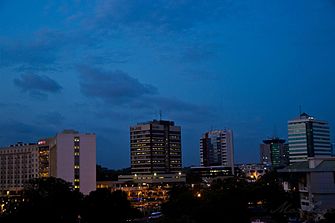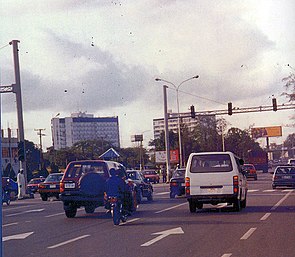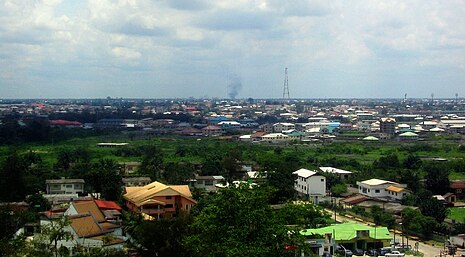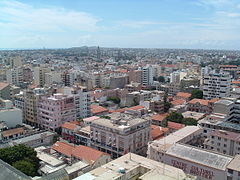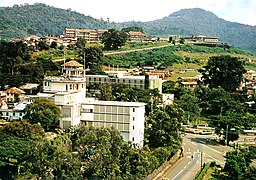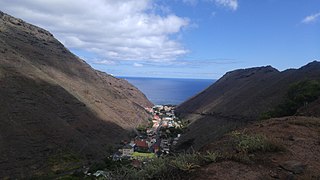West Africa
| West Africa | |
|---|---|
| Density | 49.2/km2 (127.5/sq mi) |
| Demonym | West African |
| Countries | Sovereign states (16) |
| Dependencies | Economic Community of West African States (ECOWAS; established 1975) |
| Total GDP (PPP) | US$2.091 trillion (2022) (23rd)[4] |
| GDP (PPP) per capita | $2,500 (2013)[5] |
| Total GDP (nominal) | $810 billion (2023)[6][7] |
| Total GDP (nominal) per capita | $1,937 (2023)[6] |
| Currency | |
| Largest cities | |
UN M.49 code | 011 – West Africa202 – Sub-Saharan Africa002 – Africa001 – World |
West Africa or Western Africa is the westernmost region of
Early history in West Africa included a number of prominent regional powers that dominated different parts of both the coastal and internal trade networks, such as the
West Africa has a rich ecology, with strong biodiversity and several distinct regions. The area's climate and ecology are heavily influenced by the dry Sahara to the north and east, which provides dry winds during the Harmattan, as well as the Atlantic Ocean to the south and west, which provides seasonal monsoons. This mixture of climates gives West Africa a rich array of biomes, from biodiversity-rich tropical forests to drylands supporting rare and endangered fauna such as pangolins, rhinoceros, and elephants. Because of the pressure for economic development, many of these ecologies are threatened by processes like deforestation, biodiversity loss, overfishing, pollution from mining, plastics and other industries, and extreme changes resulting from climate change in West Africa.
History
The history of West Africa can be divided into five major periods: first, its prehistory, in which the first human settlers arrived, developed agriculture, and made contact with peoples to the north; the second, the Iron Age empires that consolidated both intra-Africa, and extra-Africa trade, and developed centralized states; third, major polities flourished, which would undergo an extensive history of contact with non-Africans; fourth, the colonial period, in which Great Britain and France controlled nearly the entire region; and fifth, the post-independence era, in which the current nations were formed.
Prehistory
West African populations were considerably mobile and interacted with one another throughout the
During the
Empires
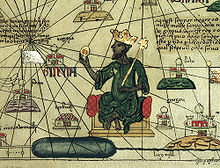
The development of the region's economy allowed more centralized states and civilizations to form, beginning with
Three great kingdoms were identified in Bilad al-Sudan by the ninth century. They included Ghana,
The

Meanwhile, south of the Sudan, strong city-states arose in
The Kingdom of Nri was a West African medieval state in present-day southeastern Nigeria and a subgroup of the Igbo people. The Kingdom of Nri was unusual in the history of world government in that its leader exercised no military power over his subjects. The kingdom existed as a sphere of religious and political influence over a third of Igboland and was administered by a priest-king called as an
The
The Benin Empire was a
European contact and enslavement

Portuguese traders began establishing settlements along the coast in 1445, followed by the
Colonialism
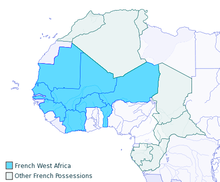
In the early 19th century, a series of Fulani reformist
However, the
Part of the West-African regions underwent an increase in the numeracy level throughout the 19th century. The reason for such a growth was predetermined by a number of factors. Namely, the peanut production and trade, which was boosted by the demand of the colonial states. Importantly, the rise of the numeracy was higher in the regions which were less hierarchical and had less dependent from the slavery trade (e.g. Sine and Salum). Whereas areas with the opposite trends illustrated opposite tendencies (e.g. central and northern Senegal). Those patterns were further even more stimulated with the French colonial campaign.[44]
Britain controlled the Gambia, Sierra Leone, Ghana, and Nigeria throughout the colonial era, while France unified Senegal, Guinea, Mali, Burkina Faso, Benin, Ivory Coast, and Niger into
Postcolonial era
Following World War II, nationalist movements arose across West Africa. In 1957, Ghana, under Kwame Nkrumah, became the first West African colony to achieve its independence, followed the next year by France's colonies (Guinea in 1958 under the leadership of President Ahmed Sekou Touré); by 1974, West Africa's nations were entirely autonomous.
Since independence, many West African nations have been submerged under political instability, with notable civil wars in Nigeria, Sierra Leone, Liberia, and Ivory Coast, and a succession of military coups in Ghana and Burkina Faso.
Since the end of colonialism, the region has been the stage for some brutal conflicts, including:
- Nigerian Civil War
- First Liberian Civil War
- Second Liberian Civil War
- Guinea-Bissau Civil War
- Ivorian Civil War
- Sierra Leone Rebel War
- Mali War
Geopolitical division
| * Benin * Burkina Faso * Cape Verde * Ivory Coast * The Gambia | * Ghana * Guinea * Guinea-Bissau * Liberia * Mali | * Niger * Nigeria * Senegal * Sierra Leone * Togo |
Area
In the
List of countries
 Benin
Benin Burkina Faso
Burkina Faso Cape Verde
Cape Verde Ivory Coast
Ivory Coast The Gambia
The Gambia Ghana
Ghana Guinea
Guinea Guinea-Bissau
Guinea-Bissau Liberia
Liberia Mali
Mali Niger
Niger Nigeria
Nigeria Senegal
Senegal Sierra Leone
Sierra Leone Togo
Togo United Kingdom
United Kingdom
 United Kingdom Overseas Territory)
United Kingdom Overseas Territory)
Cities
Major and principal cities in West Africa include, geographically eastward:
|
|
Environment
Nature

Before European colonisation, West African countries such as those from the Senegambia region (Senegal and the Gambia) used to have a diverse wildlife including lions, hippopotamus, elephants, antelopes, leopards etc.[53] However, during colonization, the European colonizers such as the French and British killed most of the wildlife particularly the lions, using their body parts as trophies. By the turn of the 20th century, the Senegambia region had lost most of its lion population and other exotic animals due to poaching. By the 1930s, the Gambian elephant population became extinct. That phenomenon was not only limited to the Senegambia region but affected much of West Africa as the region lost much of its "natural resources once tied so closely to its cultural identity. Poaching has stolen most of its wildlife." The British issued poaching licenses, and although they would later try to reverse the damage that had been done by attempting to preserve what was left of the local wildlife, but by that time, it was too late.[54][55] During the 1930s, the elephant population in the Gold Coast was about 300, and Sierra Leone between 500 and 600. Although a small number of elephants survived in Nigeria, hunting, agricultural expansion and clearing of forest in that country drastically affected its wildlife population, particularly elephants.[55]
Despite the historical damage that has been done to the region's wildlife populations, there are still some protected nature reserves within the region. Some of these include:
- The Bandia Nature Reserve in Senegal (French: Réserve de Bandia), animal life includes: tortoises. apes and a variety of exotic birds.[56]
- The bushbuck and hippopotamus.[57]
- The Diana monkey, and other primates.[58]
- The Mole National Park is Ghana's biggest wildlife refuge. It is home to over 83 mammal species including about 800 resident elephants, buffalo, hippos, and warthogs[59][60] as well as various fauna and flora.
West Africa is also home to several

Deforestation
West Africa is greatly affected by deforestation and has one of worst deforestation rate.[63] Even "the beloved baobab tree" which is viewed as sacred by some West African cultures are under threat due to climate change, urbanization and population growth. "Huge swaths of forest are being razed to clear space for palm oil and cocoa plantations. Mangroves are being killed off by pollution. Even wispy acacias are hacked away for use in cooking fires to feed growing families."[54] Nigeria, Liberia, Guinea, Ghana and the Ivory Coast, have lost large areas of their rainforest.[64][65] In 2005, the Food and Agriculture Organization of the United Nations ranked Nigeria as the state with the worst deforestation rate in the entire world. Causes include logging, subsistence agriculture, and the collection of fuelwoods.[66]
According to a
Overfishing
Overfishing is a major issue in West Africa. Besides reducing fish stocks in the region, it also threatens food security and the livelihoods of many coastal communities who largely depend on artisanal fishing. The overfishing generally comes from foreign trawlers operating in the region.[67]
To combat the overfishing, Greenpeace has recommended countries reduce the number of registered trawlers operating in African waters, increase the monitoring and control and set up regional fisheries organizations.[68] Some steps have already been taken in the form of WARFP (the World Bank's West Africa Regional Fisheries Program which empowers west-African countries (i.e. Liberia, Sierra Leone, Cape Verde, and Senegal) with information, training and monitoring systems. Furthermore, Liberia enacted a fisheries regulations Act in 2010[69] and installed a satellite-based monitoring system and Senegal enacted a fisheries code in 2015. In Cape Verde, the fishermen communities of Palmiera and Santa Maria have organized themselves to protect fishing zones. Mozambique finally created a conservation area, including a coastline. [70][71]
Geography and climate
West Africa, broadly defined to include the western portion of the Maghreb (Western Sahara, Morocco, Algeria, and Tunisia), occupies an area in excess of 6,140,000 km2, or approximately one-fifth of Africa. The vast majority of this land is plains lying less than 300 meters above sea level, though isolated high points exist in numerous states along the southern shore of West Africa.[72]
| Western Afrotropical realm | |||
|
 |
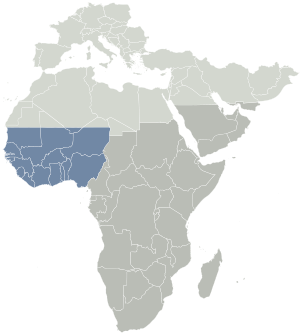 | |
| State | The biostate | Location in Afrotropic |

The northern section of West Africa (narrowly defined to exclude the western Maghreb) is composed of semi-arid terrain known as Sahel, a transitional zone between the Sahara and the West Sudanian savanna. Forests form a belt between the savannas and the southern coast, ranging from 160 km to 240 km in width.[73]
The northwest African region of Mauritania periodically suffers country-wide plagues of locusts which consume water, salt and crops on which the human population relies.[74]
Background
West Africa is west of an imagined north–south axis lying close to
Colonial boundaries are reflected in the modern boundaries between contemporary West African states, cutting across ethnic and cultural lines, often dividing single ethnic groups between two or more states.[76]
In contrast to most of Central, Southern, and Southeast Africa, West Africa is not populated by Bantu-speaking peoples.[77]
Climate change
The West African region can be divided into four climatic sub-regions namely the Guinea Coast, Soudano-Sahel, Sahel (extending eastward to the Ethiopian border) and the Sahara,[78] each with different climatic conditions. The seasonal cycle of rainfall is mainly driven by the south-north movement of the Inter-Tropical Convergence Zone (ITCZ) which is characterised by the confluence between moist southwesterly monsoon winds and the dry northeasterly Harmattan.[79]
Based on the inter-annual rainfall variability, three main climatic periods have been observed over the Sahel: the wet period from 1950 to the early 1960s followed by a dry period from 1972 to 1990 and then the period from 1991 onwards which has seen a partial rainfall recovery.[80][81][82] During the dry period, the Sahel experienced a number of particularly severe drought events, with devastating effects.[83][84] The recent decades, have also witnessed a moderate increment in annual rainfall since the beginning of 1990s. However, total annual rainfall remains significantly below that observed during the 1950s.[85][83]
Some have identified the two recent decades as a recovery period.[86] Others refer to this as a period of "hydrological intensification" with much of the annual rainfall increase coming from more severe rain events and sometimes flooding rather than more frequent rainfall, or similarly other works[87][88] underline the continuity of the drought even though the rainfall has increased. Since 1985, 54 percent of the population has been affected by five or more floods in the 17 Sahel region countries.[89] In 2012, severe drought conditions in the Sahel were reported. Governments in the region responded quickly, launching strategies to address the issue.[90]
The region is projected to experience changes in rainfall regime, with climate models suggesting that decreases in wet season rainfall are more likely in the western Sahel, and increases more likely in the central to east Sahel, although opposite trends cannot yet be ruled out.[91][92][93] These trends will affect the frequency and severity of floods, droughts, desertification, sand and dust storms, desert locust plagues and water shortages.[94][95]
However, irrespective of the changes in seasonal mean rain, the most intense storms are expected to become more intense, amplifying flood frequency.[96][97] Enhanced carbon emissions and global warming may also lead to an increase in dry spells especially across the Guinea Coast associated with a reduction of the wet spells under both 1.5 °C and 2 °C global warming level.[98]
Fifteen percent of Sahel region population has also experienced a temperature increase of more than 1 °C from 1970 to 2010. The Sahel region, in particular, will experience higher average temperatures over the course of the 21st century and changes in rainfall patterns, according to the Intergovernmental Panel on Climate Change (IPCC).Transport
Rail transport

A Trans-ECOWAS project, established in 2007, plans to upgrade railways in this zone. One of the goals of the

Road transport
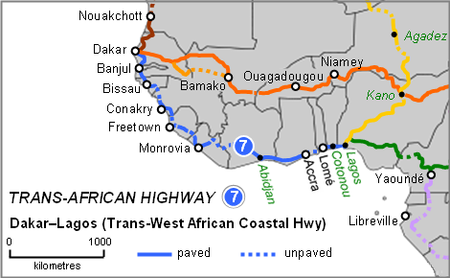
The Trans–West African Coastal Highway is a transnational highway project to link 12 West African coastal states, from Mauritania in the north-west of the region to Nigeria[100] in the east, with feeder roads already existing to two landlocked countries, Mali and Burkina Faso.[101]
The eastern end of the highway terminates at
- Nouakchott–Lagos Highway
- Lagos–Nouakchott Highway
- Dakar–Lagos Highway
- Lagos–Dakar Highway
- Trans-African Highway 7 in the Trans-African Highwaynetwork
Air transport
The capitals' airports include:
- Cadjehoun Airport (COO) International; Cotonou, Benin
- Ouagadougou Airport(OUA); Ouagadougou, Burkina Faso
- Amílcar Cabral International Airport (SID); Praia, Cape Verde
- Banjul International Airport (BJL) International; Banjul, Gambia
- Kotoka International Airport (ACC); Accra; Ghana
- Conakry International Airport(CKY); Conakry, Guinea
- Osvaldo Vieira International Airport (OXB); Bissau, Guinea-Bissau
- Port Bouet Airport(ABJ); Abidjan, Ivory Coast
- Roberts International Airport (ROB); Monrovia, Liberia
- Bamako–Sénou International Airport(BKO); Bamako, Mali
- Nouakchott–Oumtounsy International Airport (NKC); Nouakchott, Mauritania
- Diori Hamani International Airport (NIM); Niamey, Niger
- Murtala Muhammed International Airport (LOS); Lagos, Nigeria
- Saint Helena Airport; Jamestown, Saint Helena
- Blaise Diagne International Airport (DSS); Dakar, Senegal
- Lungi International Airport(FNA); Freetown, Sierra Leone
- Lomé–Tokoin Airport(LFW); Lomé, Togo
Of the sixteen, the most important hub and entry point to West Africa are Kotoka International Airport, and Murtala Muhammed International Airport, offering many international connections.
Health
West Africa has made considerably improvement in the health outcomes of its populations, in spite of the challenges posed by pervasive poverty, epidemic diseases, and food insecurity. The traditional communicable diseases of HIV/AIDS, malaria, and tuberculosis are still the major reasons of mortality. Primary health care is the best answer to curing diseases, as it provides the basic preventive strategies as it reduce the rate of child and maternal morbidity and mortality—two of the most preventable outcomes that can prolong life expectancy at birth.[102] Recently, mental health problems are on the rise in West Africa, as they are in many other world regions. However, the subject is largely a taboo, and professional treatment is still rare.[103]
Culture
Despite the wide variety of cultures in West Africa, from
Art
Traditional architecture

The main traditional styles of building (in conjunction with modern styles) are the distinct Sudano-Sahelian style in inland areas, and the coastal forest styles more reminiscent of other sub-Saharan areas. They differ greatly in construction due to the demands made by the variety of climates in the area, from tropical humid forests to arid grasslands and deserts. Despite the architectural differences, buildings perform similar functions, including the compound structure central to West African family life or strict distinction between the private and public worlds needed to maintain taboos or social etiquette.[citation needed]
Clothing

In contrast to other parts of the continent south of the
), who wear them as a gesture of national pride.Cuisine

Scores of foreign visitors to West African nations (e.g.,
West Africans cuisines include fish (especially among the coastal areas), meat, vegetables, and fruits—most of which are grown by the nations' local farmers. In spite of the obvious differences among the various local cuisines in this multinational region, the foods display more similarities than differences. The small difference may be in the ingredients used. Most foods are cooked via boiling or frying. Commonly featured, starchy vegetables include
Recreation and sports

The board game oware is quite popular in many parts of Southern Africa. The word "Oware" originates from the Akan people of Ghana. However, virtually all African peoples have a version of this board game.[116] The major multi-sport event of West Africa is the ECOWAS Games which commenced at the 2012 ECOWAS Games.
Music

Mbalax, Highlife, Fuji, Afrobeat, and Afrobeats are modern musical genres of West Africa and its diaspora. Traditional folk music is also well-preserved. Some types of folk music are religious in nature such as the "Tassou" tradition used in Serer religion.[120]
Griot artists
In other areas of West Africa, primarily among the
Theatre
Film industry
Religion
Islam
African traditional
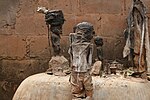
Most traditional religious organizations "do not have a formal hierarchy of priests."[126] Group rituals are usually overseen by tribal elders who, "within many cultures", "serve as the main religious figures and determine the time, nature, and intricacies of rituals", or shaman priests who can use magic to heal, control fate, and connect to the spirit world.[126]
Christianity

In 2010, around 20% of West Africans identified as
Demographics and languages

West Africans primarily speak
Colonial languages also play a pivotal cultural and political role, being adopted as the official languages of most countries in the region, as well as linguae franca in communication between the region's various ethnic groups. For historical reasons, Western European languages such as
Architecture
Further information in the sections of Architecture of Africa:
- Prehistoric West African Architecture
- Ancient West African Architecture
- Medieval West African Architecture
Science and technology
Further information in the sections of History of science and technology in Africa:
Economic and regional organizations

Economic Community of West Africa
The Economic Community of West African States (ECOWAS; also known as CEDEAO in French and Portuguese) is a regional political and economic union of fifteen countries located in West Africa. Collectively, these countries comprise an area of 5,114,162 km2 (1,974,589 sq mi) and have an estimated population of over 424.34 million.[131]
Considered one of the pillar regional blocs of the continent-wide African Economic Community (AEC), the stated goal of ECOWAS is to achieve "collective self-sufficiency" for its member states by creating a single large trade bloc by building a full economic and trading union. Additionally, ECOWAS aims to raise living standards and promote economic development.[132] The union was established on 28 May 1975, with the signing of the Treaty of Lagos, with its stated mission to promote economic integration across the region. A revised version of the treaty was agreed and signed on 24 July 1993 in Cotonou, the largest city in Benin.[133]
ECOWAS's fundamental principles rely on equity, inter-dependence, solidarity, co-operation, nonaggression, regional peace, promotion of human rights, and economic and social justice.[134]
Notably among ECOWAS's protocols and plans are the ECOWAS Free Movement of Persons, Residences and Establishment Protocol and the Ecotour Action Plan 2019–2029. The Free Movement of Persons Protocol permits citizens the right to enter and reside in any member state's territory,[135] and the Ecotour Action Plan aims to develop and integrate the tourist industry of each member state.[136]
ECOWAS also serves as a peacekeeping force in the region, with member states occasionally sending joint military forces to intervene in the bloc's member countries at times of political instability and unrest.[137][138]
In 2024, Niger, Burkina Faso, and Mali announced their withdrawal from the bloc. The countries had been suspended from ECOWAS due to military takeovers of their respective governments. The announcement of the withdrawal of the three junta-led states came after ECOWAS had threatened to use military force, by deploying its standby force, should the coup leaders fail to reinstate constitutionally elected presidents and governments, a threat which ECOWAS lacked the support, wherewithal and institutional strength to follow through.[139]West African Monetary Union
The
Women's peace movement
Since the adoption of the United Nations Security Council Resolution 1325 in 2000, women have been engaged in rebuilding war-torn Africa. Starting with the Women of Liberia Mass Action for Peace and Women in Peacebuilding Network (WIPNET), the peace movement has grown to include women across West Africa.
Established on May 8, 2006,
Pray the Devil Back to Hell is a documentary film about the origin of this peace movement. The film has been used as an advocacy tool in post-conflict zones like Sudan and Zimbabwe, mobilizing African women to petition for peace and security.[142]
Gallery
Cityscapes of the largest cities
Capital cities of West Africa
- Capital cities of West Africa
-
Praia, Cape Verde
-
Dakar, Senegal
-
Lomé, Togo
-
Porto-Novo, Benin
-
Niamey, Niger
-
Ouagadougou, Burkina Faso
-
Freetown, Sierra Leone
-
Banjul, Gambia
-
Conakry, Guinea
-
Bissau, Guinea-Bissau
-
Monrovia, Liberia
-
Bamako, Mali
-
Nouakchott, Mauritania
-
Abuja, Nigeria
-
Accra, Ghana
-
Abidjan, Ivory Coast
-
Yamoussoukro, Ivory Coast
-
Jamestown, Saint Helena, Ascension and Tristan da Cunha
See also
- African historiography
- Agroecology in West Africa
- Ajami– Arabic word referring to people whose first language is not Arabic
- Ebola virus epidemic in West Africa– 2013–2016 major disease outbreak
- List of regions of Africa
- Manillas– West African money, a form of archaic money unique to West Africa
- N'Ko script – Alphabet for the Manding languages of West Africa
- North Africa – Northernmost region of Africa
- Nsibidi Script – Ancient writing system, an indigenously developed West African writing system
- Sub-Saharan Africa – Region south of the Sahara Desert
- Central Africa – Core region of African continent
- East Africa – Eastern region of the African continent
- Southern Africa – Southernmost region of the African continent
- Vai syllabary – Writing system
- West African Craton – One of the five cratons of the Precambrian basement rock of Africa that make up the African Plate
- Western Sahara – Territory in North and West Africa
References
- ^ a b c "World Population Prospects 2022". United Nations Department of Economic and Social Affairs, Population Division. Retrieved 17 July 2022.
- ^ a b c "World Population Prospects 2022: Demographic indicators by region, subregion and country, annually for 1950-2100" (XSLX) ("Total Population, as of 1 July (thousands)"). United Nations Department of Economic and Social Affairs, Population Division. Retrieved 17 July 2022.
- ^ a b United Nations Department of Economic and Social Affairs, Population Division (2017). World Population Prospects: The 2017 Revision, custom data acquired via website. [1]
- ^ "IMF GDP 2011". Retrieved 17 October 2014.
- ^ "IMF GDP data, September 2011". Retrieved 17 October 2014.
- ^ a b "IMF GDP data, October 1515". Retrieved 17 October 2014.
- ^ "Nigerian Economy Overtakes South Africa's on Rebased GDP". Bloomberg News. 7 April 2014. Retrieved 17 October 2014.
- ^ a b c "United Nations Statistics Division – Standard Country and Area Codes Classifications". Archived from the original on 13 July 2011. Retrieved 17 October 2014.
- ISBN 1-58906-014-8
- ^ "West African population, 1950–2050 | West Africa Gateway | Portail de l'Afrique de l'Ouest". west-africa-brief.org. Archived from the original on 30 October 2021. Retrieved 30 October 2021.
- ^ "UEMOA economies are projected to grow by 6.6% in 2020 | West Africa Gateway | Portail de l'Afrique de l'Ouest". www.west-africa-brief.org. Archived from the original on 30 October 2021. Retrieved 30 October 2021.
- S2CID 127485241.
- ISBN 978-0-19-027773-4.
- ^ S2CID 161691927.
- S2CID 228826414.
- PMID 29727585.
- S2CID 231583475.
- ^ S2CID 163304839.
- S2CID 130112115.
- ^ S2CID 160957067.
- OCLC 1330712064.
- JSTOR 43135518.
- ^ ISBN 978-0-19-085458-4.
- ^ a b Blench, Roger (21 October 2017). "Africa over the last 12000 years: how we can interpret the interface of archaeology and linguistics?". University of Cambridge. pp. 13, 25.
- OCLC 1261367188.
- ProQuest 2403309251.
- ^ S2CID 3302383.
- .
- S2CID 132225521.
- ISSN 2499-1341.
- ISSN 2499-1341.
- ^ ISBN 978-1-58839-687-7.[page needed]
- ^ S2CID 160637192.
- ISBN 978-1588396877.
- ^ OCLC 1395910241.
- ^ Hales, Kevin (2015). The Moving Finger: A Rhetorical, Grammatological and Afrinographic Exploration of Nsibidi in Nigeria and Cameroon (Thesis). p. 15.
- ^ S2CID 234783117.
- ^ S2CID 155124324.
- S2CID 54463512.
- S2CID 126989016.
- ISBN 978-0841904316.
- ^ "Historical survey: Slave-owning societies". Encyclopædia Britannica. Archived from the original on 23 February 2007.
- ISBN 978-1-107-09485-7.
- ^ Baten, Jörg (May 2017). "European Trade, Colonialism and Human Capital Accumulation in Senegal, Gambia and Western Mali, 1770 – 1900". CESifo Working Papers.
- ^ "The UN office for West Africa" (PDF). Archived from the original (PDF) on 16 May 2006.
- ^ Polski Instytut Spraw Międzynarodowych, Studies on the Developing Countries, Issues 6–8, Polish Institute of International Affairs (1988), p. 53
- ^ "Office for North Africa of the Economic Commission for Africa". United Nations Economic Commission for Africa. Retrieved 17 October 2014.
- ^ "2014 UNHCR country operations profile – Mauritania". Retrieved 17 October 2014.
- ^ "African Development Bank Group: Mauritania". Retrieved 17 October 2014.
- ISBN 143812676X: "The Islamic Republic of Mauritania, situated in western North Africa..."
- ISBN 020340291X: "We have, by contrast, chosen to include the predominantly Arabic-speaking countries of western North Africa (the Maghreb), including Mauritania (which is a member of the Arab Maghreb Union)..."
- ISBN 1849207291: "The Magrebian countries or the Arab countries of western North Africa (Algeria, Libya, Mauritania, Morocco and Tunisia)..."
- ISBN 9780791031353.
- ^ a b c The New York Times, "Across Senegal, the Beloved Baobab Tree Is the 'Pride of the Neighborhood'", by Dionne Searcey (Sept. 30, 2018) (Retrieved 1 April 2019)
- ^ ISBN 9781849046763 [2](Retrieved 1 April 2019)
- ^ Bandia Nature Reserve is sometimes called Bandia park reserve, Lonely Planet, Half-Day Somone Lagoon and Bandia Park Safari from Dakar, [3] (Retrieved 1 April 2019)
- ^ Lonely Plane, Yankari National Park[4] (Retrieved 1 April 2019)
- .
- OCLC 59347952.
- OCLC 233549707.
- ^ Martin, V.; Becker, C. (1979). "Lieux de culte et emplacements celebres dans les pays Sereer (Sénégal)" [Places of worship and famous locations in the Sereer countries (Senegal)]. Bulletin de l'Institut Fondamental d'Afrique Noire, Série B: Sciences humaines (in French). 41: 133–189.
- ^ "The Seereer Resource Centre (SRC)". The Seereer Resource Centre (SRC). Archived from the original on 30 April 2019. Retrieved 1 April 2019.
- ^ ThoughtCo, The Territory and Current Status of the African Rainforest by Steve Nix (November 04, 2018) [5](Retrieved 2 April 2019)
- ^ Deforestation by Country & Region ("Country Forest Data [sorted by region]") [in] Mongabay.com (Retrieved 2 April 2019)
- ^ Rainforest Destruction [in] rainforestweb.org. Archived by Wayback Machine — [6] (Retrieved 2 April 2019)
- ^ Mongabay News, Nigeria has worst deforestation rate, FAO revises figures (17 November 2005) by Rhett A. Butler, [7] (Retrieved 2 April 2019)
- ^ "Overfishing destroying livelihoods | Africa Renewal". www.un.org. 12 May 2017.
- ^ "Greenpeace welcomes cancellation of fishing licences of 29 foreign trawlers". African Manager. 4 May 2012. Retrieved 1 July 2022.
- ^ "Liberia Gets New Fisheries Regulations". Fisheries Committee for the West Central Gulf of Guinea. 5 January 2011. Retrieved 1 July 2022.
- ^ "Cape Verde: Greenpeace Raises Awareness on the State Of Fisheries in West Africa". Archived from the original on 28 July 2019. Retrieved 28 July 2019.
- ^ "Overfishing threatens food security off Africa's western and central coast as many fish species in the region face extinction – IUCN report". IUCN. 19 January 2017.
- ^ ISBN 3-642-12956-0
- ISBN 3-642-12956-0
- ^ National Geographic, February 2013, p. 8.
- ISBN 1-74104-821-4
- ISBN 978-8422-07-1
- ISBN 0-631-23583-3
- .
- .
- .
- .
- S2CID 134207640.
- ^ doi:10.1002/joc.5530.
- .
- .
- S2CID 129607595.
- .
- .
- ^ Livelihood Security Climate Change, Migration and Conflict in the Sahel Archived 28 February 2017 at the Wayback Machine 2011
- ^ Fominyen, George. "Coming weeks critical to tackle Sahel hunger – U.N. humanitarian chief". Thomson Reuters Foundation. Archived from the original on 3 June 2012. Retrieved 10 June 2012.
- .
- .
- PMID 31015416.
- ^ "IPCC Sees Severe Climate Change Impacts on Africa". ABC Live. ABC Live. Retrieved 7 September 2016.
- ^ Vogel, Coleen. "Why Africa is particularly vulnerable to climate change". The Conversation. Retrieved 7 August 2017.
- .
- PMID 31015416.
- .
- ^ a b "Proposed Ecowas railway" Archived 2009-10-24 at the Wayback Machine. railwaysafrica.com.
- ^ a b Nigeria Real Estate Market Review (PDF). Northcourt.[page needed]
- ^ Itai Madamombe (2006): "NEPAD promotes better transport networks", Africa Renewal, Vol. 20, No. 3 (October 2006), p. 14.
- PMC 7123888.
- ^ Abi, Samir (12 June 2019). "Metaphysical explanations". D+C, Development and Cooperation.
- ^ Barbara K. Nordquist, Susan B. Aradeon, Howard University. School of Human Ecology, Museum of African Art (U.S.). Traditional African dress and textiles: an exhibition of the Susan B. Aradeon collection of West African dress at the Museum of African Art (1975), pp. 9–15.
- ISBN 0-595-30528-8.[page needed]
- ISBN 0-495-11541-X.
- ^ UNESCO. The Case for indigenous West African food culture, p. 4. BREDA series, Vol. 9 (1995), (UNESCO).
- ISBN 0-19-280681-5.
- Senegambians borrowed from the Mandinka language.
- ISBN 0-89680-272-8.
- ISBN 1-84353-083-X.
- ISBN 1-85109-700-7.
- ISBN 1-60844-735-9.
- ISBN 0-7614-7827-2.
- ^ "Customs & Cuisine of Niger | Amman Imman | Dining for Women". Archived from the original on 20 September 2020. Retrieved 29 May 2020.
- ^ West Africa, issues 4106–4119, pp. 1487–8. Afrimedia International, (1996)
- ^ "Why does the West dominate African football?" BBC.
- ^ "Wafu Cup to make a comeback". BBC Sport. 29 September 2008. Retrieved 15 July 2015.
- ^ "Caf have split the West African Football Union into two separate zones". Goal.com. 17 May 2011. Retrieved 15 July 2014.
- ^ Ali Colleen Neff, Tassou: the Ancient Spoken Word of African Women. 2010.
- ^ "Nigeria surpasses Hollywood as world's second-largest film producer – UN". United Nations. 5 May 2009. Retrieved 30 September 2009.
- ^ "The Islamic World to 1600: The Fractured Caliphate and the Regional Dynasties (West Africa)". Archived from the original on 25 October 2013.
- ^ Muslim Societies in African History (New Approaches to African History), David Robinson, Chapter 1.
- ^ Spread of Islam in West Africa (part 1 of 3): The Empire of Ghana, Prof. A. Rahman I. Doi, Spread of Islam in West Africa. http://www.islamreligion.com/articles/304/
- ISBN 9966-46-928-1
- ^ ISBN 0-415-94180-6.
- ISBN 0-495-05053-9
- S2CID 165905763.
- ISBN 1-55876-015-6
- ISBN 0-85255-995-X
- ^ "Members of the ECOWAS – Economic Community of West African States". Worlddata.info. Archived from the original on 16 December 2023. Retrieved 16 December 2023.
- ^ "Economic Community of West African States (ECOWAS)". United States Trade Representative. Archived from the original on 11 October 2023. Retrieved 12 October 2023.
- ^ "Revised ECOWAS Treaty (1993) | International Investment Agreements Navigator | UNCTAD Investment Policy Hub". investmentpolicy.unctad.org. Archived from the original on 20 October 2023. Retrieved 12 October 2023.
- ^ Limited, Daniel Inaju-Challydoff. "Fundamental Principles | Economic Community of West African States (ECOWAS)". Archived from the original on 31 October 2023. Retrieved 15 October 2023.
- .
- ProQuest 2232643790.
- ^ Adeyemi, Segun (6 August 2003). "West African Leaders Agree on Deployment to Liberia". Jane's Defence Weekly.
- ^ "The 5 previous West African military interventions". Yahoo News. AFP. 20 January 2017. Archived from the original on 28 November 2020. Retrieved 27 January 2017.
- ^ "Ecowas' dilemma: Balancing principles and pragmatism - The Nordic Africa Institute NAI Policy Note 2024:1". nai.uu.se. Retrieved 11 April 2024.
- ^ a b "WIPSEN". Retrieved 17 October 2014.
- ^ "WIPSEN EMPOWERS WOMEN…To fight for their rights". Ghana Media Group. 11 December 2010. Archived from the original (article) on 17 September 2011.
- ^ November 2009 MEDIAGLOBAL Archived 2010-07-10 at the Wayback Machine
Further reading
- Akyeampong, Emmanuel Kwaku. Themes in West Africa's History (2006).
- Brydon, Lynne. "Constructing Avatime: questions of history and identity in a West African polity, c. 1690s to the twentieth century." Journal of African History 49.1 (2008): 23–42. online
- Collins, Robert O. African History: Western African History (1990).
- Davidson, Basil. A History of West Africa, 1000–1800 (1978), numerous editions
- Delavignette, Robert. Freedom and Authority in French West Africa (Routledge, 2018).
- Dueppen, Stephen A. "The archaeology of West Africa, ca. 800 BCE to 1500 CE." History Compass 14.6 (2016): 247–263.
- Edgerton, Robert B. The Fall of the Asante Empire: The Hundred-Year War For Africa'S Gold Coast (2002).
- Fage, J. D. A Guide to Original Sources for Precolonial Western Africa Published in European Languages (2nd ed. 1994); updated in Stanley B. Alpern, ed. Guide to Original Sources for Precolonial Western Africa (2006).
- Festus, Jacob et al. eds. History of West Africa (Vol. 1, 1989).
- Greene, S. E. Sacred Sites and the Colonial Encounter: A History of Meaning and Memory in Ghana (2002).
- Griswold, Wendy. Writing African women: Gender, popular culture and literature in West Africa (Zed Books Ltd., 2017).
- Ham, Anthony. West Africa (2013) online.
- Hayward, Derek F., and Julius Oguntoyinbo. Climatology of West Africa (Routledge, 2019).
- Hopkins, Antony Gerald. An economic history of West Africa (2014) online.
- Huber, Caroline, Lyn Finelli, and Warren Stevens. "The economic and social burden of the 2014 Ebola outbreak in West Africa." Journal of infectious diseases 218.Supplement_5 (2018): S698–S704.
- Kane, Ousmane Oumar, Beyond Timbuktu: An Intellectual History of Muslim West Africa (2016).
- Lavallée, Emmanuelle; Roubaud, François (3 June 2019). "Corruption in the Informal Sector: Evidence from West Africa". The Journal of Development Studies. 55 (6): 1067–1080. S2CID 158886041.
- Law, Robin (1985). "Human Sacrifice in Pre-Colonial West Africa". African Affairs. 84 (334): 53–87. JSTOR 722523.
- Mann, Gregory (2005). "Locating Colonial Histories: Between France and West Africa". The American Historical Review. 110 (2): 409–434. JSTOR 10.1086/531320.
- Martinez-Alvarez, Melisa; Jarde, Alexander; Usuf, Effua; Brotherton, Helen; Bittaye, Mustapha; Samateh, Ahmadou L; Antonio, Martin; Vives-Tomas, Joan; D'Alessandro, Umberto; Roca, Anna (May 2020). "COVID-19 pandemic in west Africa". The Lancet Global Health. 8 (5): e631–e632. PMID 32246918.
- Mazrui, Ali A. Islam and the English language in East and West Africa (Routledge, 2017).
- Meillassoux, Claude, ed. The development of indigenous trade and markets in West Africa: studies presented and discussed at the tenth International African seminar at Fourah Bay college, Freetown, December 1969 (Routledge, 2018).
- Mendonsa, Eugene L. West Africa: An Introduction to Its History (2002)
- O'Brien, Donal Cruise, Richard Rathbone, John Dunn, eds. Contemporary West African States (2002) online free to borrow
- Soares, Benjamin (March 2014). "The Historiography of Islam in West Africa: An Anthropologist's View". The Journal of African History. 55 (1): 27–36. S2CID 162823960.
- Tonkin, Elizabeth. Narrating our pasts: The social construction of oral history (Cambridge university press, 1995), on West Africa
- Westermann, Diedrich, and Margaret Arminel Bryan. The Languages of West Africa: Handbook of African Languages (Routledge, 2017).
External links
- West Africa by Region and Country – African Studies at Columbia University
- ouestaf.com – Ouestaf, a West African online newspaper (in French)
- Loccidental Archived 7 March 2006 at the Wayback Machine – An online West African newspaper (in French)
- West Africa Review – An e-journal on West Africa research and scholarship (in English)
- The Voyage of the Sieur Le Maire, to the Canary Islands, Cape-Verde, Senegal, and Gambia is the first published writing about Western Africa, dating from 1695 (in English)








